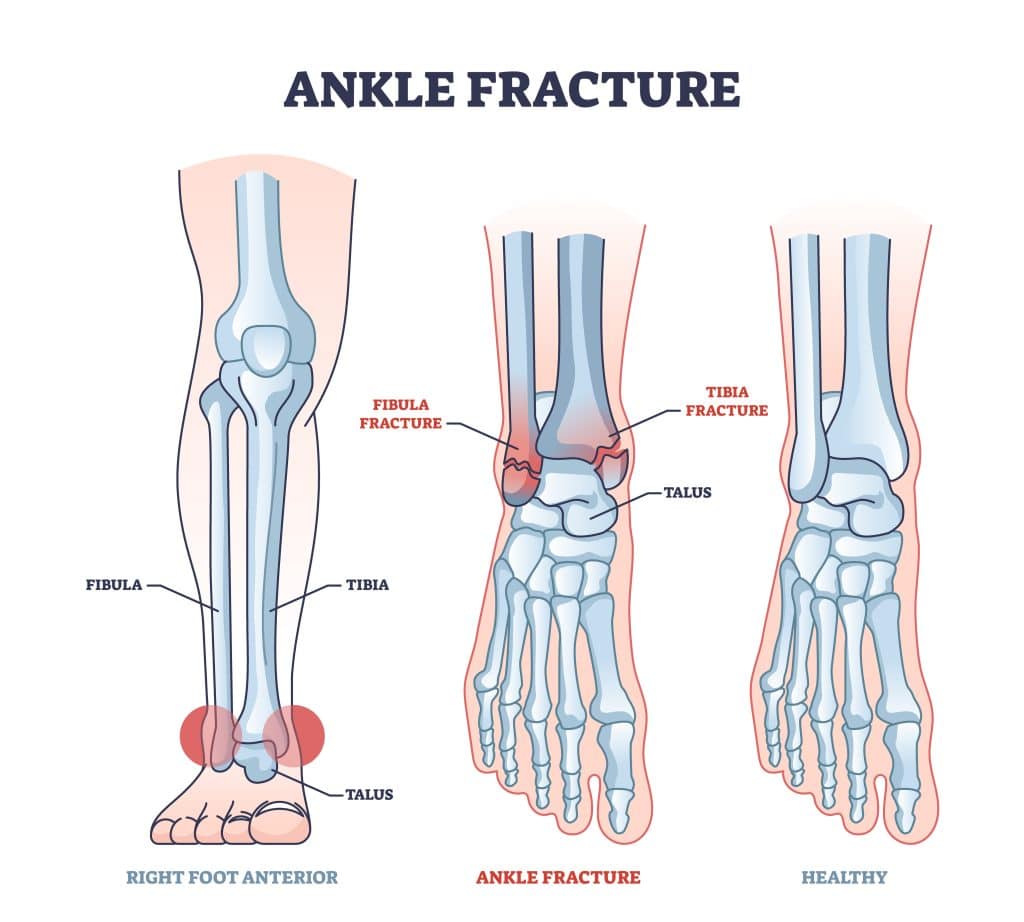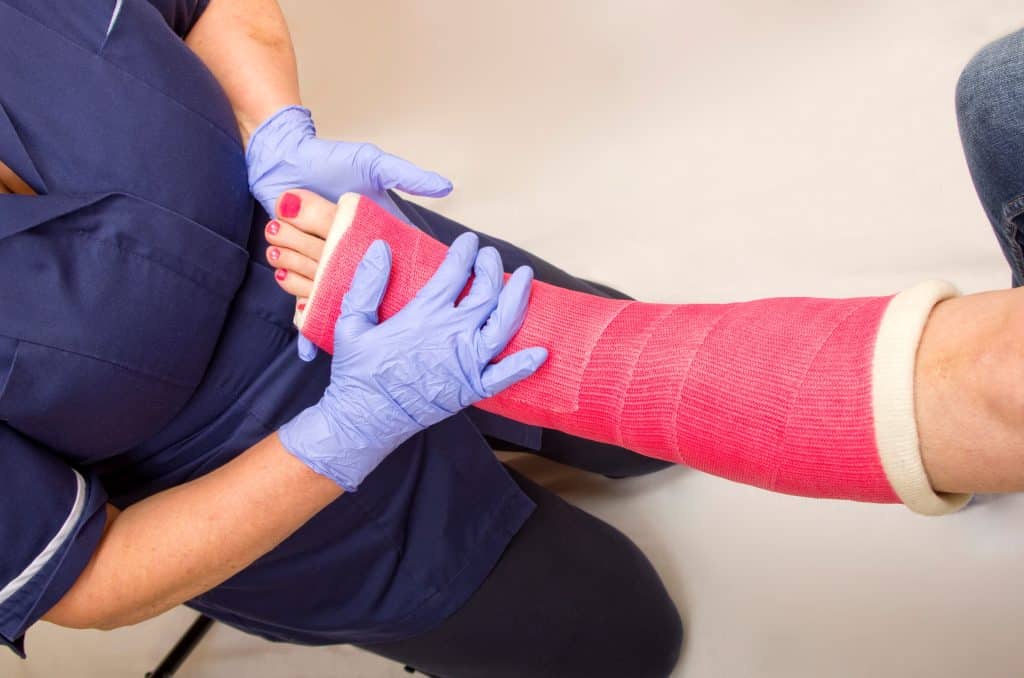Broken Ankle: Symptoms, Causes, & Treatments
On average, Americans take 3,000 to 4,000 steps each day. Each step looks simple from the outside, yet internally, each employs many muscles, tendons, ligaments, and bones in the hips, knees, and ankles. Disrupt any of these tissues, and you jeopardize your ability to get from place to place in your normal manner.
Those who’ve suffered a broken or fractured ankle know this all too well. The ankle joint moves your foot up and down and from side to side. Another joint in the ankle area, the syndesmosis joint (between the tibia and fibula), provides stability. Either of these joints can be affected if you fracture a bone or bones in the ankle, and your ankle will be increasingly unstable if you also damage any surrounding ligaments.
Causes of an Ankle Fracture

Common causes of ankle fractures include:
- Rotational injuries like rolling or twisting your ankle when walking, running, or playing a sport
- High-speed impacts, such as tripping, falling, or a car accident
These types of injuries are usually sudden and are known as traumatic injuries. Breaks that occur over time due to repetitive impacts are called stress fractures.
Ankle Anatomy
The ankle joint is made up of three bones: the tibia, the fibula, and the talus. The tibia and fibula are the two bones of the lower leg. The talus is the small bone between these bones and the heel bone.
If you break a bone in your ankle or syndesmosis joint, your orthopedic foot and ankle specialist will diagnose your injury using a physical exam and an X-ray. They may also take a CT scan or MRI to evaluate the extent of the break and look for damage to surrounding soft tissues.
Symptoms of a Fractured Ankle
Common symptoms of a broken ankle include:
- Immediate pain
- Swelling
- Bruising
- Tenderness to touch
- Inability to walk or put weight on your foot
- Obvious deformity
- Numbness or coldness in the foot
Ankle Fracture Types
Orthopedic specialists classify ankle fractures according to the severity and location of the break.
Common types of fractures include:

- Open or compound fracture — a break where the bone(s) comes through the skin
- Closed or simple fracture — a break where the bone(s) stays within the skin
- Displaced or dislocated fracture — a break where the bone(s) move out of its normal position
- Nondisplaced fracture — a break where the bone(s) stays in its normal position
- Lateral malleolus fracture — a break on the outside of the ankle at the end of the fibula; the most common type of ankle fracture
- Medial malleolus fracture — a break on the inside of the ankle at the end of the tibia; commonly associated with breaks in other parts of the ankle
- Posterior malleolus fracture – a break on the back of the tibia; commonly associated with a break in other parts of the ankle
- Bimalleolar fracture — a break in both the tibia and fibula; this is the second-most common type of fracture and is commonly dislocated
- Bimalleolar equivalent fracture — a break in either the tibia or fibula combined with a ligament injury; the ligament injury causes partial or total dislocation
- Trimalleolar fracture — a break in the tibia, fibula, and posterior malleolus; this type of fracture is commonly dislocated
- Pilon fracture — a break in the central portion of the lower tibia
- Syndesmosis injury — a break in one of the bones of the ankle joint plus a ligament sprain or a ligament sprain alone (typically called a high ankle sprain)
Treatment of a Broken Ankle
Displaced and open fractures are the most serious types of breaks. Displaced fractures must be reduced, a procedure where your orthopedic specialist moves the bone(s) back into its normal position, which may require foot and ankle surgery. Open fractures also require surgery and are a medical emergency due to the possibility of dirt and debris getting into the wound and causing an infection.
Broken ankles that need surgery may require screws or plates to rejoin the bone(s) and hold it in place. You’ll wear a splint for a couple of weeks and must elevate your ankle most of the time. After your surgeon removes your sutures, you’ll wear a walking boot and can start moving your ankle. You will not be weight-bearing for the first 4 to 6 weeks, however. Provided the bone is healing well after this time, your orthopedic foot and ankle surgeon will clear you to begin putting weight on your ankle and begin physical therapy. You may also benefit from laser therapy for foor pain as you start using your ankle again.
Nonsurgical Treatment for an Ankle Fracture

Nonsurgical treatments for non-displaced broken ankles typically involve a hard cast followed by additional weeks in a walking boot.
You may initially need crutches, a walker, or a cane to lessen the weight you put on your ankle.
Elevate your foot while seated and sleeping to decrease swelling, and use prescribed and over-the-counter pain relievers as directed.
Your orthopedic foot and ankle specialist will take periodic X-rays to ensure the bones are healing. Once your specialist removes your hard cast, use a wrapped ice pack in 20- to 30-minute increments to help the pain and swelling.
How long does a fractured ankle take to heal?
Most broken ankles take a minimum of 6 weeks to heal. Healing often takes longer if soft tissues like ligaments and tendons are also injured. Follow the instructions given by your orthopedic specialist to avoid reinjuring your ankle or negatively impacting its healing.

Your orthopedic specialist will give you exercises for strengthening your ankle and recapturing its flexibility and range of motion. They may also refer you to a physical therapist and recommend you wear a brace for a certain period or during certain activities.
Many people who break their ankles experience stiffness and swelling for months after their injury, with complete recovery taking up to 2 years. Continue using rehabilitation exercises and elevating and icing your ankle. Those who smoke, have diabetes, or are elderly are at higher risk for delayed healing and complications like osteoarthritis.
If you have a foot or ankle injury or have questions about keeping your ankles strong and flexible, please contact us or comment below.
Leave a Reply